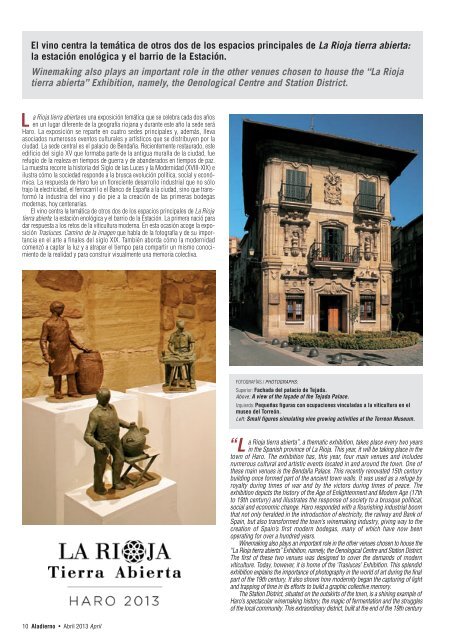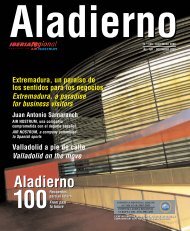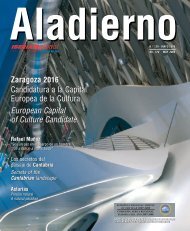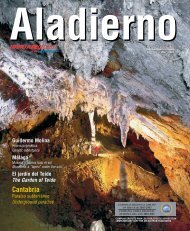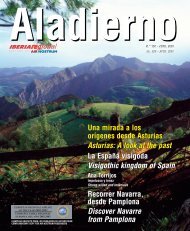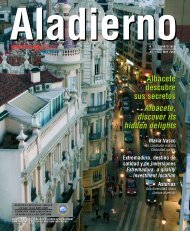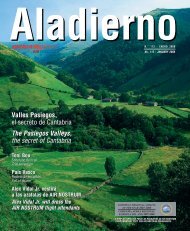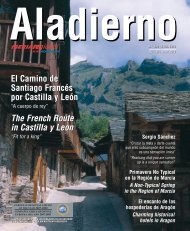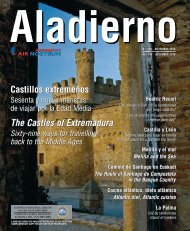Create successful ePaper yourself
Turn your PDF publications into a flip-book with our unique Google optimized e-Paper software.
El vino centra la temática de otros dos de los espacios principales de La Rioja tierra abierta:<br />
la estación enológica y el barrio de la Estación.<br />
Winemaking also plays an important role in the other venues chosen to house the “La Rioja<br />
tierra abierta” Exhibition, namely, the Oenological Centre and Station District.<br />
L<br />
a Rioja tierra abierta es una exposición temática que se celebra cada dos años<br />
en un lugar diferente de la geografía riojana y durante este año la sede será<br />
Haro. La exposición se reparte en cuatro sedes principales y, además, lleva<br />
asociados numerosos eventos culturales y artísticos que se distribuyen por la<br />
ciudad. La sede central es el palacio de Bendaña. Recientemente restaurado, este<br />
edificio del siglo XV que formaba parte de la antigua muralla de la ciudad, fue<br />
refugio de la realeza en tiempos de guerra y de abanderados en tiempos de paz.<br />
La muestra recorre la historia del Siglo de las Luces y la Modernidad (XVIII-XIX) e<br />
ilustra cómo la sociedad responde a la brusca evolución política, social y económica.<br />
La respuesta de Haro fue un floreciente desarrollo industrial que no sólo<br />
trajo la electricidad, el ferrocarril o el Banco de España a la ciudad, sino que transformó<br />
la industria del vino y dio pie a la creación de las primeras bodegas<br />
modernas, hoy centenarias.<br />
El vino centra la temática de otros dos de los espacios principales de La Rioja<br />
tierra abierta: la estación enológica y el barrio de la Estación. La primera nació para<br />
dar respuesta a los retos de la viticultura moderna. En esta ocasión acoge la exposición<br />
Trasluces. Camino de la imagen que habla de la fotografía y de su importancia<br />
en el arte a finales del siglo XIX. También aborda cómo la modernidad<br />
comenzó a captar la luz y a atrapar el tiempo para compartir un mismo conocimiento<br />
de la realidad y para construir visualmente una memoria colectiva.<br />
FOTOGRAFÍAS / PHOTOGRAPHS:<br />
Superior: Fachada del palacio de Tejada.<br />
Above: A view of the façade of the Tejada Palace.<br />
Izquierda: Pequeñas figuras con ocupaciones vinculadas a la viticultura en el<br />
museo del Torreón.<br />
Left: Small figures simulating vine growing activities at the Torreon Museum.<br />
“L<br />
a Rioja tierra abierta”, a thematic exhibition, takes place every two years<br />
in the Spanish province of La Rioja. This year, it will be taking place in the<br />
town of Haro. The exhibition has, this year, four main venues and includes<br />
numerous cultural and artistic events located in and around the town. One of<br />
these main venues is the Bendaña Palace. This recently renovated 15th century<br />
building once formed part of the ancient town walls. It was used as a refuge by<br />
royalty during times of war and by the victors during times of peace. The<br />
exhibition depicts the history of the Age of Enlightenment and Modern Age (17th<br />
to 19th century) and illustrates the response of society to a brusque political,<br />
social and economic change. Haro responded with a flourishing industrial boom<br />
that not only heralded in the introduction of electricity, the railway and Bank of<br />
Spain, but also transformed the town’s winemaking industry, giving way to the<br />
creation of Spain’s first modern bodegas, many of which have now been<br />
operating for over a hundred years.<br />
Winemaking also plays an important role in the other venues chosen to house the<br />
“La Rioja tierra abierta” Exhibition, namely, the Oenological Centre and Station District.<br />
The first of these two venues was designed to cover the demands of modern<br />
viticulture. Today, however, it is home of the ‘Trasluces’ Exhibition. This splendid<br />
exhibition explains the importance of photography in the world of art during the final<br />
part of the 19th century. It also shows how modernity began the capturing of light<br />
and trapping of time in its efforts to build a graphic collective memory.<br />
The Station District, situated on the outskirts of the town, is a shining example of<br />
Haro’s spectacular winemaking history, the magic of fermentation and the struggles<br />
of the local community. This extraordinary district, built at the end of the 19th century<br />
10 <strong>Aladierno</strong> • Abril 2013 April


